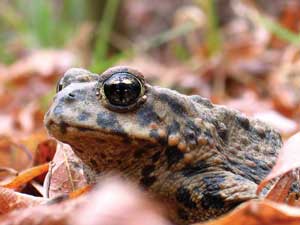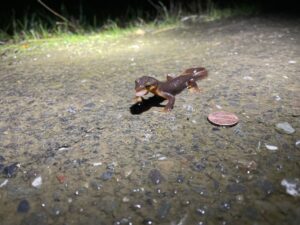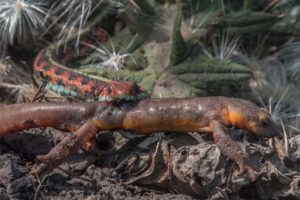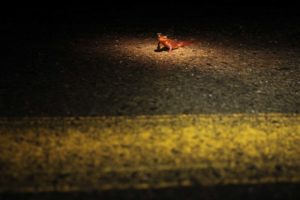On rainy days, wildlife watching outdoors is probably not at the top of your list, but there is one group of animals that reigns supreme during this season: amphibians. Salamanders, newts, frogs, and toads are now at their peak of activity, feeding and breeding in swollen creeks, streams, and ponds, and in woodlands and grasslands soaked by winter rains.
Five kinds of salamander, two kinds of toad, and four frog species live in the Bay Area. Most amphibians need to stay wet, or at least a little bit moist. They breathe through their skin, and without water, they will dry out and die. And they have to breed in water, since their eggs lack the protective shells of reptile and bird eggs. So rainy winter days are the very best time to see these wild creatures!
- Slender salamander. Photo by Bob Clay
Nearly every suburban neighborhood, park, and backyard is home to the slender salamander. These tiny wormlike creatures with short legs feed on all sorts of small terrestrial invertebrates (snails, worms, etc.). You will find them under outdoor planters, in piles of firewood, under tree bark, or among damp leaves. Once uncovered, they bolt into action like coiled springs breaking free—that’s an attempt to startle would-be predators.
You’re more likely to hear than see our second-most-common amphibian. The Pacific chorus frog (or tree frog) is the Bay Area’s most vocal frog. Groups of males singing to attract a mate can be deafening. These frogs like ponds and slow-moving streams, where the females lay clusters of eggs attached to floating vegetation or roots. By late winter, hundreds of tiny tadpoles emerge; they grow throughout the summer, sprouting legs and finally leaving the water to settle amid streamside boulders, in rodent burrows, or under thick vegetation.
In the eastern Bay Area, American bullfrogs may be more abundant than the tiny chorus frogs. These nonnatives were introduced during the Gold Rush and have spread throughout the state, often displacing native frogs, whose eggs they devour. Thousands of these potato-size frogs live in Delta waterways, cattle ponds, irrigation ditches, and canals. Their basso “jug-o’-rum” call is as unmistakable as their green heads, which you can sometimes see poking above the water. Unlike most native species, this frog stays in water throughout the year.
Look for California newts as they migrate to local ponds and streams each winter to breed. Chocolate-colored backs and yellowish bellies set them apart from other salamanders. They stay in the water for a couple of months, then return to the woodland to spend the rest of the year hidden in old logs or rodent burrows.

- Western toad. Photo courtesy of Rana Creek.
Our local western toad, with dry, warty skin and a thin cream-colored line running down its back, was once common in nearly all local creeks and streams. Its numbers have declined dramatically, probably because of pollution in urban waterways.
You’re less likely to see the California tiger salamander, arboreal salamander, and the ensatina. California red-legged frogs live in the Bay Area but are increasingly uncommon due to habitat loss. The foothill yellow-legged frog may still exist in coastal streams or along undisturbed inland creeks. The spadefoot toad lives in the driest inland parts of our region, and it spends most of the year dormant and buried in mud, so it is almost never seen.
But even if you can’t see them, you can help them. How? Join a creek cleanup in your neighborhood, raise Pacific chorus frogs in your classroom, or make your backyard a good home for amphibians.

.jpg)




